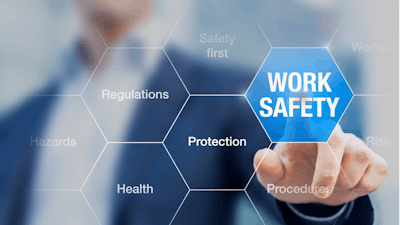
Championing safety within an organization is not always top of mind for employers and, as a result, measures and methods may be outdated or ineffective. However, showing interest in safety on even a small scale makes a big impression and lasting impact.
Seeing and hearing leadership engaged in safety positively influences everyone within an organization. Company leaders are able to make the most impact by promoting safety from the top down, and their bird’s-eye view of the entire company provides them with a unique opportunity to see the benefits of a strong safety culture. In fact, safe working environments can lead to higher levels of productivity, better quality work, and increased employee job satisfaction. It’s a win-win situation for both the company and employees.
It’s in the hands of employers to find a balance in how they value safety, productivity, and quality of work. Challenges such as a lack of time, resources, and knowledge can strain the workforce and result in a compromised commitment to safety. It’s critical that employers mitigate these challenges from the start by incorporating safety into the foundation of their organization.
Safety needs to be woven into every aspect of how a company conducts its business. Vision, mission, and value statements are just commitments in writing and require action to realize their benefits. As we enter the new year, now is the time to take a closer look at company safety measures.
Communicating Safety Across the Organization
Company executives have the power to set the tone of an organization. It’s typical to hear leaders only discuss the business cost of an employee’s injury, but that thinking isn’t effective for everyone. It’s up to the employers to foster psychological safety by creating an environment where workers feel empowered to speak up. Employees should be encouraged to report unsafe conditions or actions/behaviors without a concern for retribution.
Even shifting language can plant the seeds for psychological safety. Personal Action Plans are a great tool for senior leaders to incorporate safety into everyday routines. Leaders can pinpoint manageable ways to show up for their organization by identifying safety-oriented actions to be completed daily, weekly and monthly.
While it’s important to call out issues within a workplace’s safety protocols, it’s essential to celebrate the wins. One example is to implement a “Safety Champion of the Month.” This peer-to-peer recognition program includes a mini-celebration and appreciation from the company with a gift card to treat the worker’s family to dinner. Programs like this help companies move safety from head to heart. Once the worker truly believes the employer has their best interests in mind, compliance is more easily achieved.
Incorporating new protocols is a balancing act - it doesn't have to be a night and day shift. Small gestures like speaking up at company trainings, participating in safety drills, and communicating the importance of safety are impactful ways for leadership to increase engagement and be both seen and heard across the company right away.
The Power of Proactivity
Applying safety to a company project must be prioritized from day one. Leaders and managers must identify risks, select the proper equipment, and determine next steps for a project’s success. Waiting until the project is underway may make it more difficult to apply safety controls to reduce the risk. One might assume safety protocols are well-known or leaders may feel that there’s not enough time in the day to implement trainings. And while these assumptions are common, they have dangerous consequences.
We’ve all heard horror stories of a dangerous, sometimes deadly, incident on the job. Waiting until these “come-to” moments is risky and results in distrust from teams, or in the worst-case scenario, the devastating loss of an employee’s life. Therefore, by building programs that include measurable checks and balances, routinely reviewing safe work practices, communicating safety protocols, and implementing trainings, leaders are able to demonstrate to employees that their safety matters and the company is not waiting for a wake-up call to take action.
Incorporating Online Training
Technology has the ability to streamline tasks, provide up-to-date information, and reach every employee no matter where they’re located. Leveraging technology in a safety plan is key to accessing relevant information that benefits an entire organization.
Online trainings easily address on-going industry trends and changes. While employee training cannot be static, it can be time consuming to deliver such education manually. Constantly updated, virtual trainings are a great way to deliver important information to employees across the company in a quick and easy-to-use manner. Employees can even watch online courses and complete any required materials from their phone or laptop. Access to safety information electronically also ensures that employees always have the critical information they need at their fingertips, especially in the event of an emergency.
To ensure workplaces are both as safe and functional as possible, it’s critical that leaders themselves champion safety and set the tone in the workplace in order to get buy-in from everyone. Leveraging technology is a powerful way to share trainings and safety information, but it must be coupled with communication from the top. Utilizing annual safety perception surveys help teams benchmark progress from day one and gauge any improvement to their safety culture.
Strong leaders provide the tools and resources for others to succeed. Short-changing the needs of safety increases risk and both directly and indirectly places workers in harm’s way. At the end of the day, a leader that can speak up for safety in the workplace is more likely to establish trust with employees and create a safe environment for all.





















